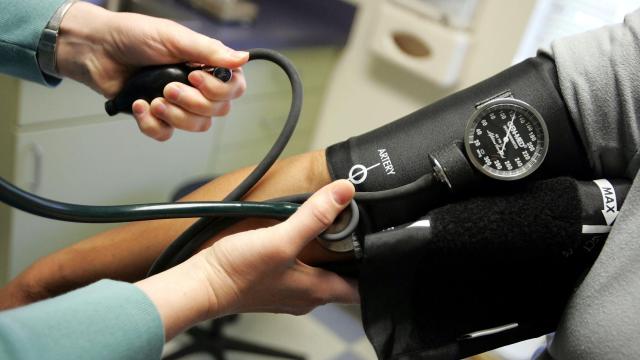More and more people around the world are living with high blood pressure, new research this week finds. The study, based on data from nearly 200 countries, estimates that more than a billion adults globally had hypertension in 2019 — double the number estimated in 1990. What’s more, more than half of these cases are going untreated, and few people are keeping it well-controlled.
High blood pressure is usually defined as consistently having systolic blood pressure 140 mm Hg or greater (the top number in a blood pressure reading) and diastolic blood pressure 90 mm Hg or greater (bottom number). Though it typically doesn’t cause any visible symptoms on its own, chronic hypertension can stress and damage the body, particularly the cardiovascular system, over time; this then raises the risk of other conditions like heart attack, stroke, and kidney disease. In the U.S. alone, hypertension was estimated to contribute to nearly 500,000 deaths in 2018.
The new research, published Tuesday in the Lancet, is the work of researchers from the NCD Risk Factor Collaboration (NCD-RisC), a network of scientists looking into the prevalence of major contributors to non-communicable diseases across the world. The group works closely with the World Health Organisation and is coordinated by researchers from Imperial College London. Their study is intended to provide the first estimates of hypertension and how it’s being diagnosed, treated, and controlled in every country.
The team reviewed 1,201 studies of more than 100 million people between the ages of 30 and 79, spanning back 30 years in 184 countries — studies that had a nationally representative sample of participants. People were defined to have hypertension if they had a 140/90 and over blood pressure reading or if they were taking blood pressure medication. This data was then used to estimate rates of hypertension in 200 countries and territories throughout those years.
All told, they estimated that 1.27 billion people between ages 30 and 79 fit the bill for hypertension in 2019, up from 650 million in 1990. After adjusting for age (older people are more likely to have hypertension and people are generally living longer now than three decades ago), though, the global prevalence of hypertension didn’t significantly change during those years, with around a third of men and women estimated to have it back in 1990 as well as in 2019.
A diet high in sodium as well as a lack of exercise can contribute to high blood pressure, while other conditions, like diabetes, are risk factors. Aside from lifestyle changes, there are readily available drugs that can help control it. But the authors estimate more than half of all cases (720 million) currently go untreated, while only around 20% of people had their blood pressure well-controlled. Poorly managed or untreated hypertension only further raises the risk of health problems.
There were some local successes, with countries such as the UK, Spain, Canada, and Switzerland experiencing a sharp drop in their prevalence of hypertension since the 1990s. But many other countries worsened or stayed the same. In two countries, Paraguay and Tuvalu, more than 50% of women had hypertension in 2019, while over 50% of men had hypertension in nine countries, including Argentina, Hungary, and Paraguay. Just over a billion people with hypertension are thought to live in low- to middle-income countries.
The U.S. ranked 38th on the list of countries with the lowest prevalence of hypertension in 2019, with no major change in prevalence since 1990. In 2019, 29% of women and 34% of men were estimated to have hypertension. But it ranked 4th in actually treating it, with 73% of people getting some amount of care. In 2017, it should be noted, new guidelines from leading organisations in the U.S. recommended that hypertension be defined as having a minimum 130/80 reading, not 140/90. The Centres for Disease Control and Prevention, using these recommendations, instead estimates that 45% of American adults over 18 have hypertension.
“Despite medical and pharmacological advances over decades, global progress in hypertension management has been slow, and the vast majority of people with hypertension remain untreated, with large disadvantages in low- and middle-income countries,” said senior author Majid Ezzati, a researcher at Imperial College London, in a statement released by the Lancet.
Because some countries have been able to improve their high blood pressure problem during these years, with some middle-income countries now doing better than most wealthier countries, the authors do hold out hope that much more can be done to reduce its threat globally. But many of the best ways to combat hypertension will depend on sweeping structural changes within these countries, as well as ample financial resources.
“Policies that enable people in the poorest countries to access healthier foods — particularly reducing salt intake and making fruit and vegetables more affordable and accessible — alongside improving detection by expanding universal health coverage and primary care, and ensuring uninterrupted access to effective drugs, must be financed and implemented to slow the growing epidemic of high blood pressure in low- and middle-income countries,” Ezzati said.
